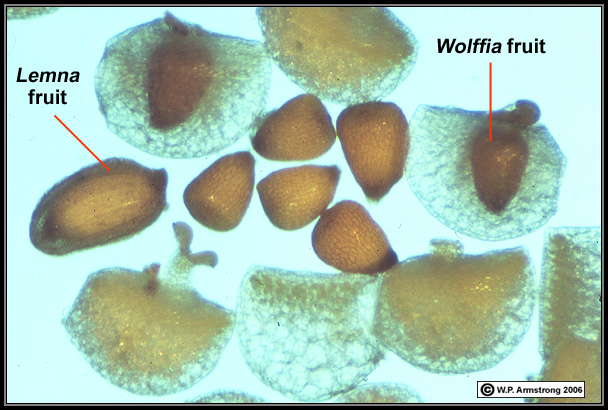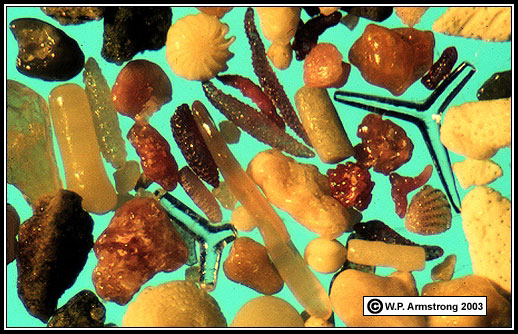|
Nature packages its seeds in botanical structures called fruits. Fruits come in an endless variety of shapes and sizes, from
papery, inflated pods of locoweeds to fleshy berries of oranges
and tomatoes. Since the January 1996 Wayne's Word Noteworthy
Plant was dedicated to the "World's Largest Fruit," it seems only
fitting that the February 1996 Noteworthy Plant should be
dedicated to the "World's Smallest Fruit." This lilliputian
botanical controversy has come up in Professor Armstrong's
Biology 100 class on several occasions, and it is time to answer
the question once and for all. Candidates for the title of
"World's Smallest Fruit" range from tiny individual seed-bearing
drupelets of blackberries and figs to the biblical mustard seed.
But none of these contenders even comes close. Is is no
coincidence that the world's smallest fruits are produced by the
world's smallest flowering plants. These remarkable plants
belong to the genus Wolffia, minute rootless plants of the
duckweed family (Lemnaceae) that float at the surface of quiet
streams and ponds. In technical botanical terms, the fruit of these tiny aquatic plants is indehiscent, bladderlike, one-seeded and is often referred to as a utricle

|
The minute one-seeded fruits of Wolffia angusta compared with grains of ordinary table salt (NaCl). The fruits (utricles) were photographed in an ethanol (ethyl alcohol) solution and the salt grains have dissolved slightly resulting in rounded corners. The cubical salt grains are about 0.3 mm on a side. Fruits of W. angusta and W. globosa and are similar in size.
|

|
The minute one-seeded fruits of Wolffia angusta compared with grains of ordinary table salt (NaCl). The cubical salt grains are about 0.3 mm on a side. The fruits of W. globosa are similar in size.
|

|
Microscopic view of three cuboidal grains of ordinary table salt (sodium chloride or NaCl). All three grains are just over one millimeter in length (red bar). Grains of table salt vary slightly in size, but three average grains stacked together adds up to approximately one mm. If three grains equal one millimeter in length, then a single grain is approximately 0.3 mm or 0.03 cm on a side.
|

|
The world's smallest fruits are produced by species of Wolffia, including the Australian W. angusta. The above image shows a mature fruit within the plant body. The larger fruit of Lemna shows a thin, transparent pericarp surrounding a ribbed seed. A pericarp layer is not evident on the wolffia fruits.
|
Two of the smallest species of Wolffia in the world are the Australian Wolffia angusta and the Asian/African Wolffia globosa. In fact, both species are so small that it is difficult to
distinguish between the size of their fruits. Since the entire
plant body of these two species is less than one millimeter long
(less than 1/25th of an inch), the tiny mature fruit takes up
most of its parent plant body. The fruit of W. angusta is only
0.30 mm long (1/100th of an inch) and weighs about 70
micrograms (1/400,000 of an ounce). One can get an idea of how
small these fruits really are when you consider that an average,
single, cubical grain of ordinary table salt (NaCl) is about 0.30
mm on a side and weighs about 60 micrograms. This fruit
is smaller than the individual cells of many plants and animals,
and is more than 4 billion times lighter than a massive world
class pumpkin. So the next time you put a pinch of table salt on
your favorite gourmet dish, think about the world's smallest
fruits which are approximately the size of one salt grain.

|
A tiny, budding Wolffia globosa plant and the minute one-seeded fruits of W. angusta compared with the eye of an ordinary sewing needle. The fruits are about 0.30 mm long. Fruits of W. angusta and W. globosa are similar in size and are the smallest fruits on earth.
|
Orchids (Orchidaceae): The World's Smallest Seeds
Certain epiphytic orchids of the tropical rain forest produce the world's smallest seeds weighing only 35 millionths of an ounce. They are dispersed into the air like minute dust particles or single-celled spores,
eventually coming to rest in the upper canopy of rain forest trees. The
world's largest seed comes from the coco-de-mer palm (Lodoicea maldivica), native to the Seychelles Archipelago in the Indian Ocean. Although it belongs to a different genus from true coconut palms (Cocos), this enormous seed is often called the "double coconut." A single seed may be 12 inches (30 cm) long, nearly three feet (0.9 m) in circumference and weigh 40 pounds (18 kg). It should be noted here that the largest seed does not have the largest embryo. In fact, palm seeds are mostly composed of endosperm tissue and generally have relatively small embryos.
|
Small seeds. Mustard family (Brassicaceae): Black mustard (Brassica nigra). Orchid family (Orchidaceae): Coral-root orchid (Corallorhiza maculata). Duckweed family (Lemnaceae): Watermeal (Wolffia angusta), a one-seeded fruit called a utricle. Poppy family (Papaveraceae): Opium poppy (Papaver somniferum). Without any doubt, the orchids have the record for smallest seeds. The seeds of some species are no larger than fungal spores and occur in a loose cellular sheath. Since the seeds have no endosperm and underdeveloped embryos, there are practically no food reserves. In order to germinate under natural conditions, they must establish a symbiotic relationship with a compatible mycorrhizal fungus. During early stages of development, the fungus supplies critical nutrients to the orchid seedling. Later the orchid may become fully independent, or it may retain its mycorrizal relationship throughout its life. The above coral-root orchid seed (Corallorhiza) grows into a nonphotosynthetic mycotrophic wildflower. It absorbs carbohydrates and minerals from its fungal host, which in turn absorbs these vital nutrients from the roots of nearby forest trees. Wolffia certainly has the record for smallest fruits which are not much larger than grains of ordinary table salt (NaCl). The single seed inside is almost as large as the fruit; therefore, wolffia seeds are not as small as orchid seeds.
|

|
Microscopic view of the seed of a coral-root orcid (Corallorhiza maculata). The individual seed is only about 0.2 mm in diameter. In fact, there are unusual bacterial cells that are larger than this orchid seed. The resolving power for an unaided human eye with 20-20 vision is about 0.1 mm. With its cellular sheath (seed coat) removed, this seed is barely visible to the naked eye. Certain epiphytic orchids of the tropical rain forest produce the world's smallest seeds weighing only 35 millionths of an ounce. One seed capsule from a single flower may contain up to four million seeds. They are dispersed into the air like minute dust particles or single-celled spores, eventually coming to rest in the upper canopy of rain forest trees. The seeds of some species are no larger than fungal spores and occur in a loose cellular sheath. Since the seeds have no endosperm and a minute, undifferentiated embryo, there are practically no food reserves. In order to germinate under natural conditions, they must establish a symbiotic relationship with a compatible mycorrhizal soil fungus. During early stages of development, the fungus supplies critical nutrients to the orchid seedling. Later the orchid may become fully independent, or it may retain its mycorrhizal relationship throughout its life. The above coral-root orchid seed (Corallorhiza) grows into a nonphotosynthetic mycotrophic wildflower that is completely dependent on its mycorrhizal fungus. Throughout its life, the orchid absorbs carbohydrates and minerals from its fungal partner, which in turn absorbs these vital nutrients from the roots of nearby forest trees. In a laboratory, orchid seeds can be grown in nutrient agar, like a sterile (axenic) culture of bacteria or fungal spores.
|

|
Lemna aequinoctialis from the Sierra San Francisco of Baja California. This view shows the basal root sheath with two lateral wings and a one-seeded fruit (utricle) protruding from a lateral budding pouch. The number of longitudinal ribs on the seed (faintly visible through the transparent pericarp) indicates that this species is L. aequinoctialis and not L. perpusilla. The head of an ordinary straight pin is used for a size relationship. It is 1.5 mm in diameter.
|
Animal Disseminules The Size Of Wolffia Seeds
Bryozoan Statoblasts & Sponge Gemmules
There are several animal reproductive disseminules in fresh water that are about the same size as wolffia seeds and fruits. They range in size from 0.2 - 0.6 mm and often show up in wolffia samples from ponds and streams. The following reference clearly determines that they have an animal origin and not reproductive bodies of duckweeds:
 Pennak, R.W. 1953. Fresh-Water Invertebrates of the United States. Pennak, R.W. 1953. Fresh-Water Invertebrates of the United States.
The Ronald Press Company, New York. 769 p.
|
Statoblasts of Bryozoans (Phylum Bryozoa)

|
The brown, disk-shaped structures mixed with these populations of Wolffia columbiana and W. borealis in the San Dieguito River of San Diego County are not wolffia fruits. They are asexual reproductive bodies called statoblasts from a freshwater bryozoan (possibly in the genus Plumatella). Bryozoans are colonial animals in the Phylum Bryozoa. The chitinous statoblasts are produced in large numbers and are dispersed by water currents where they germinate (hatch) and develop into new colonies.
|
Gemmules of Freshwater Sponges (Phylum Porifera)
|
Left: Close-up view of a freshwater sponge (possibly the genus Spongilla) showing needlelike, siliceous spicules which provide the structural skeleton to support the flimsy tissues of the body. Scattered in the sponge body are several spherical gemmules. These are resistant reproductive structures similar in function to the statoblasts of freshwater bryozoans. The structure of gemmules and spicules are used to identify different species of freshwater sponges. Right: Microscopic view of several gemmules. Each gemmule is covered with a protective outer layer and a foraminal aperture. In some species the gemmules are also covered with spicules. Gemmules are commonly produced during the fall, and like the overwintering turions of duckweeds, are able to survive severe winter conditions. They are commonly collected in duckweed samples. The gemmules can withstand repeated freezings and thawings and may be viable for three years are more. Upon germination, a creamy mass of amoebocytes slowly flows out of the foraminal aperture. The amoebocytes differentiate into the several tissue types of the new developing sponge. The following photo of tropical beach sand shows shiny, 3-pronged spicules of a marine sponge.
|

|
A magnified view of the tropical beach sand from the Caribbean island of St. John (U.S. Virgin Islands). The grains include porous fragments of brightly-colored corals, minute foraminiferan shells, fragments of sea shells and shiny, star-shaped sponge spicules.
|
|